The Magic of Inquiry and Hermit Crabs: Empowering Holistic Development in Hong Kong (Voices)
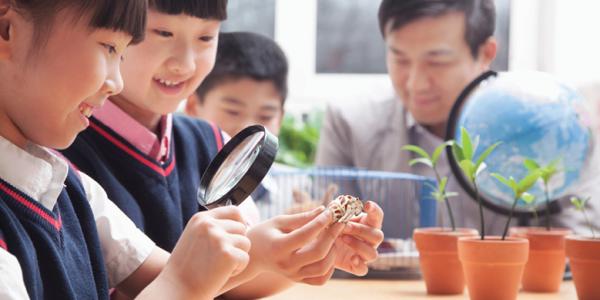
You are here
Thoughts on the Article | Andy Stremmel, Voices Executive Editor
Recognizing the importance of children’s self-directed learning through exploration of their natural environment, Suzannie Kit Ying Leung embarks upon a teacher research study focused on children’s curiosity about hermit crabs. Her work is grounded both politically and theoretically in holistic, integrated, and inquiry-based learning. Using the qualitative method of participant observation, Suzannie pays close attention to children’s conversations, raising questions to challenge their thinking and foster deep discussions. This study demonstrates in a very powerful sense what can be learned through teacher research about children, their thinking, their feelings and understandings, and their strategies for meaning making. Further, it reveals the transformative influence of teacher research in helping teachers reassess their own thinking and ideas about the competence of children and the role of parental involvement in inquiry-based curriculum.
Hong Kong is a large, cosmopolitan city. It has many wonderful cultural resources but little outdoor space in which children can explore nature. As an early childhood teacher in Hong Kong, I was concerned about helping the twelve 3- to 4-year-olds in my bilingual (Cantonese and English) class connect with nature. I was also concerned about giving them time to explore and direct their own learning.
The Hong Kong educational system is carefully planned and engaging, but the early learning curriculum requires three hours a day of teacher-directed instruction, leaving children in half-day programs without time to direct their own learning. Fortunately, I taught in a full-day (six-hour) program, and I knew that naturalistic exploration is critical for children’s development (Gardner 1983). As a result, I had the time and the knowledge I needed to enrich the children’s learning with several inquiry-based, nature-focused projects.
Among the different projects we undertook, one that the children found especially inspiring involved two hermit crabs, perhaps because children seldom have the opportunity to get in touch with nature. This inquiry began with a visit to the Hong Kong Wetland Park, where the children spent a day observing different creatures, such as crocodiles, tortoises, birds, and insects. The hermit crabs impressed them the most.
Seeing their reactions, I believed hermit crabs would make an interesting topic for further inquiry. I talked with the children after the wetlands visit, and we decided to care for two hermit crabs in the classroom, studying their characteristics and habits. Every child had an opportunity to take the hermit crabs home after school for two or three consecutive nights to develop relationships with them. After each visit, the children reported on what they did with the hermit crabs at home. Throughout the project, I engaged in teacher research to explore and document children’s questions and the way they demonstrated their understanding of the creatures through the use of the media I provided.
Policy and research foundations
Nearly 20 years ago, Hong Kong’s Education Commission (which advises the government) emphasized that the overall aim of education is “to enable every person to attain all-round development in the domains of ethics, intellect, physique, social skills, and aesthetics according to his or her own attributes” (Education Commission 2000, 30). While that aim has primarily been pursued through a government-developed curriculum with little flexibility, changes are now under way.
Holistic learning can be achieved only if the curriculum respects children’s autonomy.
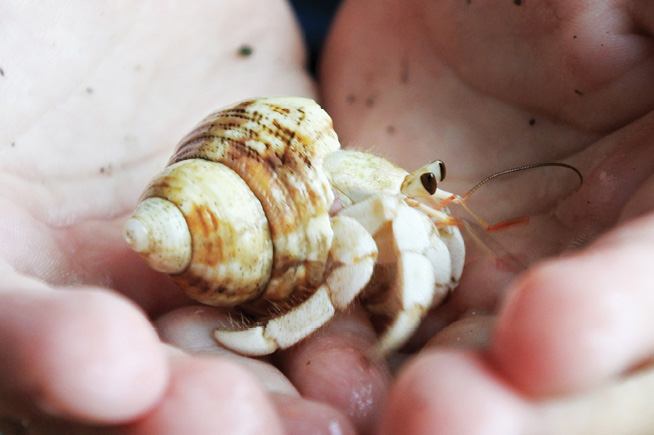 Hong Kong’s Curriculum Development Council recently published a curriculum framework that calls for an integrated curriculum (2017). This is a welcome change, as holistic learning can be achieved only if the curriculum is integrated and open (Haddad 2002) and respects children’s autonomy by providing time for inquiry-based learning.
Hong Kong’s Curriculum Development Council recently published a curriculum framework that calls for an integrated curriculum (2017). This is a welcome change, as holistic learning can be achieved only if the curriculum is integrated and open (Haddad 2002) and respects children’s autonomy by providing time for inquiry-based learning.
Inquiry-based learning is a dynamic process—an approach to “exploring the natural or material world, and that leads to asking questions, making discoveries, and rigorously testing those discoveries in the search for new understanding” (National Science Foundation 2000, 2). My research study is grounded in the theoretical framework of inquiry-based learning through a project. Projects allow students to study a topic of interest in greater detail (Katz & Chard 2000). The project approach is rooted in John Dewey’s ([1938] 1966) philosophy of learning by doing. When children work on projects, they record what is of interest to them without any prompting from the teachers (Lowenfeld & Brittain 1987; Griebling 2011). Engaging in projects is a useful approach because children need multiple means of exploration in order to enhance their investigations and increase retention of their new understandings (Davis & Keller 2009).
During our hermit crab project, children engaged in naturalistic and scientific inquiry.
Aligning with Hong Kong’s new emphasis on integrated curriculum, projects connect different subject areas, various competencies, and academic and social skills, facilitating children’s holistic development. During our hermit crab project, children engaged in naturalistic and scientific inquiry and also created visual representations of their explorations (Malaguzzi 1998). Present throughout the project was the element of play—a primary way young children learn, socialize with others, understand their own feelings and others’ perspectives, and become members of the classroom community (Elgas 2003; Riley et al. 2008.
Research questions and methods
My entire class engaged in the hermit crab investigation for a month, shortly after our Wetland Park visit. To help children gain an understanding of hermit crabs, I first introduced the children to the storybook, A House for Hermit Crab, by Eric Carle. Then I placed a children’s encyclopedia in the science corner that the children could refer to while learning how to take care of the crabs in real life. Every day, at a learner corner for science exploration, children observed the two hermit crabs. At night, with assistance from their families, children took turns caring for the hermit crabs at home, carefully completing their own visual diaries. When they brought the crabs back to school, children shared their experiences with classmates, illustrating the activities they did with the crabs.
Throughout the project, my research questions were
- What sorts of questions do children ask when exploring hermit crabs?
- How do children use the materials I provide to represent their understandings of hermit crabs?
- How does my facilitation help guide and sustain the children’s interest, exploration, and understanding?
I chose the role of participant observer for this study. Participant observation is a technique of collecting central ethnographic data when an observer is attached to the situation (Punch 2005). My main methods of collecting data were observing, taking notes, taking photographs, and having conversations with the children. Observations are critical—they allow teachers to make specific plans and adjustments to accommodate children’s varying rates of development (Jablon, Dombro, & Dichtelmiller 2007). They are also helpful for collecting data in authentic situations. As a participant observer, I took anecdotal notes, which are detailed, narrative accounts that factually describe a particular event (Jablon, Dombro, & Dichtelmiller 2007). I recorded events and conversations as they happened, jotting field notes during class and adding details later. During the children’s inquiry activities, I probed their learning and understanding by raising questions to challenge their thinking and foster higher-order discussions (Ogu & Schmidt 2009).
Natural creatures and inquiring minds
I opened the project by inviting children to observe the hermit crabs during their free activity time. Children were able to observe and study the crabs daily to develop their understanding of the hermit crabs and their relationships with them. To engage the children in drawing as a research tool and a powerful means of representing their thinking (Veale 2005; Roberts-Holmes 2011), I placed colored pencils and paper nearby, so the children could freely draw what they observed. Then I collected their drawings and recorded their thoughts about the crabs through naturalistic observation and anecdotal records.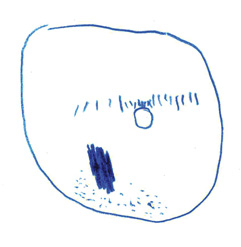
Sum observed the crabs during the first four days and began an interesting relationship with them. She assumed that the crabs were her classmates, saying, “We’ve got two new classmates here. But why they are sleeping always?” When I asked her about her drawing, she explained that the circle at the top represented the hermit crab, and their tank and the sand were drawn at the bottom. Her drawing demonstrated that she was at the schematic stage (Steele 1998), as most kindergartners are (Lowenfeld & Brittain 1987), because she tried to represent objects by using symbols in two dimensions.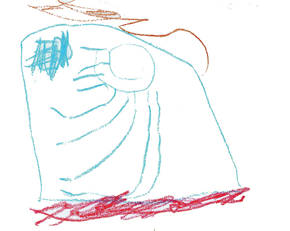
On the second day, Sum gained more information about hermit crabs through observation and started to understand the crabs’ physical structure. She noted, “I can see his legs, Miss Leung. The hermit crab has lots of legs. He is leaving his room and climbing on the sand!” She drew the legs in the picture and the circle became a swirl—much closer to the image of a shell.
S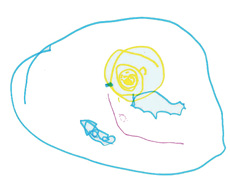 um’s excitement about the hermit crabs must have been evident at home; her father took her to the beach to collect some shells for the crabs as their “new clothes.” Sum displayed empathy toward the crabs on the third day, when she drew the shells she had collected for them. She said, “I put the shells into their house. So happy that they are having new clothes!” She humanized the crabs, believing they would change clothes like people did. The swirling shells in her picture became much more detailed.
um’s excitement about the hermit crabs must have been evident at home; her father took her to the beach to collect some shells for the crabs as their “new clothes.” Sum displayed empathy toward the crabs on the third day, when she drew the shells she had collected for them. She said, “I put the shells into their house. So happy that they are having new clothes!” She humanized the crabs, believing they would change clothes like people did. The swirling shells in her picture became much more detailed.
On the fourth day, Sum drew two hermit crabs and wished to be their friend. She happily shared, “I am a friend of the hermit crabs. Do you know that they are good friends, too? He is very friendly and always walks 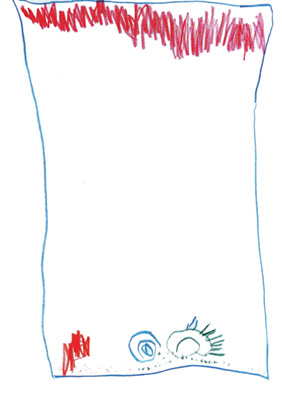 around, and she looks so shy.” Pointing to her drawing, Sum added, “He is the one on the right side, and she is the one on the left.” She identified their gender by referring to their social characteristics, suggesting her strong stereotyped perceptions of males and females.
around, and she looks so shy.” Pointing to her drawing, Sum added, “He is the one on the right side, and she is the one on the left.” She identified their gender by referring to their social characteristics, suggesting her strong stereotyped perceptions of males and females.
I interacted with the children as a colearner, facilitator, and observer throughout the project. In class discussions, I probed their thinking with questions like, “Where do the crabs live?,” “What do they eat?,” “What will they do in their living room?” Early in the project, the children made several assumptions about the hermit crabs: (1) they need to have better living conditions, like we do, including having a pillow and a bedroom; (2) they are our classmates, therefore they have to learn something new at our school; (3) they will not eat only apples, because human beings don’t eat only one kind of food; and (4) they will get bored staying in the tank without playing games.
Interior design
To address the crabs’ living conditions, the children selected materials from the art corner and began a home renovation project, using an empty milk box as a bedroom for the hermit crabs. Due to variations in their motor development, children took on different duties in completing the artwork and collaborated throughout the renovation:
Lung: The hermit crabs have got a new room now, but it looks not very nice.
Yee: People will not live in an ugly house like this!
Miss Leung: What can we do for the hermit crabs?
Ting: We can make it more beautiful, then!
Yee: I like shiny pink a lot! I want to put them in the room.
Yang: It’s nice! Let’s put some green on it. I like green!
To further improve the crabs’ quality of life, the children made them a pillow. Through the discussion, their schema about color and texture were newly expanded. By asking open-ended questions and documenting children’s thoughts, I was able to revisit and later elaborate on their questions and ideas. I also modeled my reflection by reviewing contributions from the class discussion to determine who was more active and who was more hesitant in responding (Ogu & Schmidt 2009).
The following excerpt shows how pursuing their ideas supported the children's growing understanding the hermit crabs’ actual needs:
Miss Leung: Why do we have to make a pillow for the hermit crabs?
Lee: I think it is because they have a room now, so they need a bed and a pillow, as well.
Yan: I don’t think they need a bed, since they have sand there.
Kiu: Yes, they are so poor now because they have no pillow. They cannot sleep well. See, they hid into the sand again.
Miss Leung: How can we make a pillow?
Yan: We can use something to pack the pillow.
Lee: A paper?
Kiu: [holding up two sheets] This one is yellow paper, and this one is a transparent plastic sheet.
Miss Leung: Which one is better?
Yan: The yellow paper is better because it is not transparent.
Kiu: Yes, the transparent one can see through the things.
Ming: Transparent? No, no, no.
Miss Leung: [She helps them focus their decision making by having them consider the best climate for the crabs] Do you think the inside of the crabs’ house is drier or wetter than the outside?
Yan: I don’t know
Miss Leung: Try touching the sand outside the box and then the sand inside the box. Which one is wetter?
Kiu: The inside.
Ching: The inside is wetter.
Sum: Yes.
Miss Leung: How about we put some water on the yellow paper and the transparent plastic sheet to see which one is easier to tear?
Ming: I can’t tear the transparent one.
Kiu: Oh, the yellow one is torn!
Miss Leung: Do you think we can use the yellow paper to make a pillow for the crabs?
Kiu: No, the plastic one is better.
Yan: Yes, the yellow one is easier to tear when it was wet.
Miss Leung: What shall we put inside the pillow?
Yan: Put some beans inside, like bean bags.
Lee: I like to put some sweets inside.
Sum: We can’t put sweets inside. We don’t have sweets in our pillows!
Kiu: Sand!
After the discussion, the children understood that the sand inside the box was wet to suit the crabs’ environment—hermit crabs are better off living in a humid place. After experimenting with the materials, children found that the plastic sheet could tolerate water better than the paper one. Ultimately, the children created a pillow out of red plastic packed with dry sand.
Students as teachers
To help the crabs learn something new at school, the children created a language and math activity. They designed a learning board so the hermit crabs could learn numbers, like one, two, three, four, and letters, like A, B, C. Children began to develop the concept of one-to-one correspondence (Davis & Keller 2009) with authentic hands-on counting:
Lam: [Joey starts pointing at the numbers.] This is one, and this is two.
Miss Leung: Very good Joey! Is that enough?
Yee: They have to learn more, Miss Leung. Let’s count to four.
Miss Leung: Okay, sure!
Pui: [Mary points and reads.] This is A, and this is B, and this is C.
A balanced meal
The children’s third assumption, that the hermit crabs wouldn’t eat just apples, surfaced after they fed the crabs only apples for an entire week. They felt that “human beings cannot eat just one kind of fruit.” The children decided to provide different fruits to the hermit crabs. Not knowing the crabs’ taste preferences, they suggested four kinds of fruit: strawberry, banana, mango, and orange. The children tasted these fruits and sorted them into sweet and sour groups. Since they needed to know whether or not the hermit crabs had really eaten the different fruits, the children observed the hermit crabs every day. They checked whether the crabs had eaten the fruit and recorded their observations. I facilitated this by suggesting they divide into four groups. Each group was responsible for observing and recording for one day, and one kind of fruit was given each day. Children found that the crabs liked eating apples more than strawberries, mangoes, oranges, or bananas. They reported that the crabs gathered around the strawberry and hesitated for a while. The children concluded that strawberries were not the crabs’ favorite fruit, explaining that the crabs did “a taste and a nice try,” like the children often did at the supermarket with their families.
That’s entertainment
To address their assumption that the crabs would be bored, the children sang and danced in front of the crabs. They learned to fold paper into a hat to represent the crabs’ shells and write the letter H (for hermit crab) on it. The children also wrote a new rhyme to entertain the hermit crabs with:
Hermit crab, hermit crab,
Climb up the rock.
Hermit crab, hermit crab,
Say hi hi.
Hermit crab, hermit crab,
You’re so shy.
Hermit crab, hermit crab,
Don’t say bye-bye.
Encouraging expression through different media
While collecting some samples in the art corner, I discovered that the children’s artwork was influenced by the presence of the crabs. The samples showed how children’s authentic learning experiences facilitated various forms of expression through visual art, photography, music, and movement.
Yang drew a picture that reflected his personal wish to make friends, projecting that desire onto the hermit crabs. He said, “This is the hermit crabs’ house, and they have lots of friends inside. I like red color very much, so I want to decorate their house to be in red color.”
Lee explored color in her pieces. Satisfied with her artwork, she laughed as she finished, saying, “The red color is the hermit crabs’ room, and there are shells in purple and yellow.”
Looking through a camera lens, Ming got excited seeing a hermit crab eating an apple. He observed in detail the body structure of the crab. The biology learning that happened during this project was apparent when he said, “See, Miss Leung! He is eating the apple. I can see his legs and pliers. He used his pliers to take the apple!”
Parents were impressed by the children’s creative and caring thoughts about the crabs.
Sum explained that she had to take photos of the crabs to capture the pink crab’s behavior, because that crab was always hiding in the sand. She remarked, “I think the pink crab will like her new room and the learning board. Will she read it all the time?”
The children’s artistic expression was not limited to visual art. They engaged in music and movement as well, mainly in their efforts to entertain the crabs (as described earlier).
Reflections and conclusion
This teacher research study indicated that some factors are essential to effective inquiry-based curriculum design and implementation. First, parental involvement is crucial, since parents are also facilitators—or even participants—in the project. Parents should not take over children’s roles. Instead, they can help extend children’s learning from the school setting to their home. Second, learning diversity is a concern when conducting projects with children. As a teacher, I do not assume that every child has a similar level of prior knowledge. Indeed, in Hong Kong, where socioeconomic status among children is very diverse, I feel that authentic learning experiences and materials should be prepared by teachers to ensure equal learning opportunities for children and a common knowledge foundation for inquiry. In addition, in Hong Kong, a kindergarten class typically has up to 15 students. I conducted an in-depth study with my class of 12 children—a healthy class size that may help teachers cater to individual learning needs and encourage children to contribute to the project equally.
Children revised their original concepts about hermit crabs through exploration and experimentation. By the end of this project, they were all able to summarize the lifestyle of the hermit crabs—diet, living, study, and entertainment. The children stated that hermit crabs (1) live in their own shell; (2) like climbing on sand instead of learning at school; (3) enjoy eating only apples; and (4) have their own way of entertaining themselves.
The children’s initial assumptions, when compared with their conclusions, show their thoughtfulness about living things. Parents were surprised and impressed by the children’s creative and caring thoughts about the crabs, and I was encouraged to keep working with young children, finding that their abilities and behaviors exceeded my expectations. Their dialogues reveal that they were developing the intellectual ability to understand another’s perspective and feelings (Riley et al. 2008), even as they continued to display childhood egocentrism (Piaget 1959). The children selected learning experiences at their own levels of understanding and expanded their knowledge of the world and of their role in the world (Opper 1996).
As a reflective teacher-researcher, it was a fascinating research project, and I enjoyed listening to the voices and thoughts of young children in an authentic way. This project also empowered me to reassess my ideas about the competence of children and the role of parental involvement. I would like to share this project with the children’s parents and the community through newsletters and social media in the hopes that others also develop a new understanding about children’s minds and abilities.
References
Curriculum Development Council. 2017. “Kindergarten Education Curriculum Guide Provisional Final Draft.” Hong Kong: HKSAR Education Bureau.
Davis. G.A., & J.D. Keller. 2009. Exploring Science and Mathematics in a Child’s World. Upper Saddle River, NJ: Pearson.
Dewey, J. [1938] 1966. Logic: The Theory of Inquiry. New York: Holt, Rinehart, & Winston.
Education Commission. 2000. Learning for Life, Learning through Life: Reform Proposals for the Education System in Hong Kong. Hong Kong: Education Commission.
Elgas, P. 2003. “A Peer Culture Perspective on Social Group Play.” In Early Childhood Classroom Processes, eds. R. Kantor & D.E. Fernie, 39–62. Cresskill, NJ: Hampton.
Gardner, H. 1983. Frames of Mind: The Theory of Multiple Intelligences. New York: Basic Books.
Griebling, S. 2011. “Discoveries from a Reggio Inspired Classroom: Meeting Developmental Needs through the Visual Arts.” Art Education 64 (2): 6–11.
Haddad, L. 2002. An Integrated Approach to Early Childhood Education and Care. Early Childhood and Family Policy Series no. 3. Paris: UNESCO. http://unesdoc.unesco.org/images/0012/001279/127983e.pdf.
Jablon, J.R., A.L. Dombro, & M.L. Dichtelmiller. 2007. The Power of Observation: Birth to Age 8. 2nd ed. Boston: Wadsworth; Washington, DC: NAEYC.
Katz, L.G., & S.C. Chard. 2000. Engaging Children’s Minds: The Project Approach. 2nd ed. Stamford, CT: Ablex.
Lowenfeld, V., & W.L. Brittain. 1987. Creative and Mental Growth. 8th ed. New York: Prentice Hall.
Malaguzzi, L. 1998. “History, Ideas, and Basic Philosophy.” In The Hundred Languages of Children: The Reggio Emilia Approach—Advanced Reflections, 2nd. ed., eds. C. Edwards, L. Gandini, & G. Forman, 49–89. Westport, CT: Ablex.
NSF (National Science Foundation). 2000. Inquiry: Thoughts, Views, and Strategies for the K–5 Classroom. Foundations: A Monograph for Professionals in Science, Mathematics, and Technology Education, Vol. 2. Washington, DC: NSF. www.nsf.gov/pubs/2000/nsf99148/pdf/nsf99148.pdf.
Ogu, U., & S.R. Schmidt. 2009. “Investigating Rocks and Sand: Addressing Multiple Learning Styles through an Inquiry-Based Approach.” Young Children 64 (2): 12–18. www.naeyc.org/files/yc/file/200903/BTJSchmidt_Ogu_Expanded.pdf.
Opper, S. 1996. Hong Kong’s Young Children: Their Early Development and Learning. Hong Kong: Hong Kong University Press.
Piaget, J. 1959. The Language and Thought of the Child. London: Routledge and Kegan Paul.
Punch, K.F. 2005. Introduction to Social Research: Quantitative and Qualitative Approaches. Thousand Oaks, CA: Sage.
Riley, D., R.R. San Juan, J. Klinkner, & A. Ramminger. 2008. Social & Emotional Development: Connecting Science and Practice in Early Childhood Settings. St. Paul, MN: Redleaf; Washington, DC: NAEYC.
Roberts-Holmes, G. 2011. Doing Your Early Years Research Project: A Step-by-Step Guide. 2nd ed. London: Sage.
Steele, B. 1998. Draw Me a Story: An Illustrated Exploration of Drawing-As-Language. Winnipeg, Manitoba: Peguis.
Veale, A. 2005. “Creative Methodologies in Participatory Research with Children.” In Researching Children’s Experience: Approaches and Methods, eds. S. Greene & D. Hogan, 253–72. London: Sage.
Photographs: © iStock; illustrations courtesy of author
Suzannie Kit Ying Leung, PhD candidate, is a senior lecturer at The Open University of Hong Kong. She was a registered kindergarten teacher and completed principal training in Hong Kong. She has engaged in kindergarten curriculum development and teacher training, as well as curatorial work of early childhood art exhibitions. [email protected]